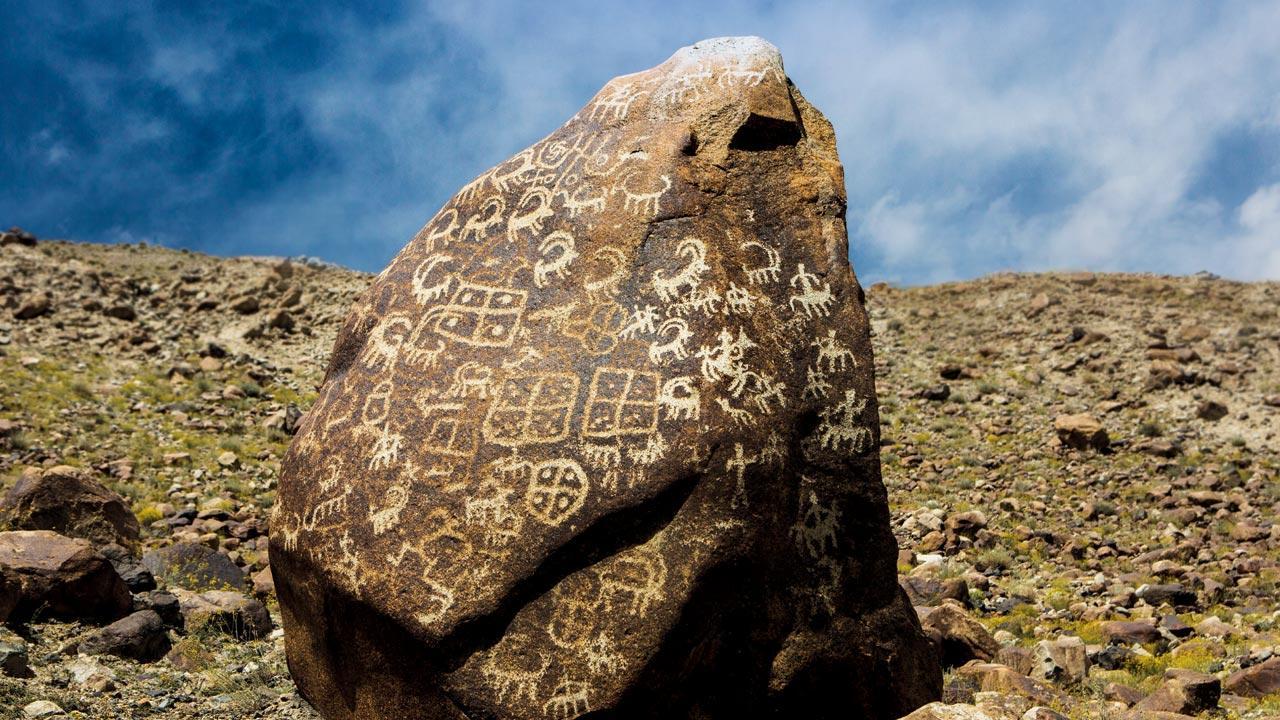An upcoming photography exhibit hopes to spread the word about Ladakh’s ancient petroglyphs that have stood for millennia but are now being demolished by modern development

The rock art stands out in the open in Ladakh’s craggy terrain, at the mercy of wind, rain, extreme temperatures and human interference
Art isn’t just to be found in the hushed hallways of museums with “Do Not Touch” signs; photographer and writer Ahtushi Deshpande spotted art where one would last expect it—out in the open in Ladakh’s craggy terrain, at the mercy of wind, rain and human interference. There, in the most inhospitable environment, she came upon petroglyphs, an ancient art form etched into rocks by our nomadic ancestors close to 3,000 years ago.
The fact that these rock carvings have survived all these millennia, open to the elements, is a marvel in itself, but even the permanence of rock is no match for time, and the petroglyphs are quickly vanishing from Ladakh. Deshpande has spent over a decade tracking down these hidden treasures and documenting them through photography. Her photographs will now be on display at an upcoming exhibition at Pratap, Kala Ghoda, from September 29 to October 15.
“On my fifth visit to Ladakh in 2011, a series of serendipitous encounters brought me face-to-face with this prehistoric art at an open air gallery along the Indus river,” she recalls.
 Ahtushi Deshpande
Ahtushi Deshpande
“Winters here are long and brutal, with temperatures plummeting to below freezing temperatures. To think that nomadic hunter-gatherers had roamed these lands thousands of years ago—navigating treacherous high passes in this seemingly landlocked region—was unfathomable. Discovering their art, the only remnants of their existence, etched into the very rocks where they had once sat and carved them, left me in awe. This experience sparked a deeper curiosity in me and somewhere along the way came the idea of capturing them on my lens,” says Deshpande.
These ancient canvases are a medium through which we can peek back through time into the the ways of life of Ladakh’s ancient residents. They depict a range of themes like the myths and legends of the time.
Over the course of documenting these petroglyphs, however, Deshpande has seen many of them disappear as they slip into rivers, get bulldozed for road expansions, or painted over with graffiti stating “Rahul waz here.”
“The rock art of Ladakh has remained unchanged for thousands of years. However, rapid development and roadwork have led to the swift disappearance of these ancient treasures over the past 10 to 15 years,” Deshpande tells Sunday mid-day.
Her new book, Speaking Stones, which has been released in Mumbai alongside her exhibition, is more than just a collection of stunning photographs. It’s a record for posterity, a last-ditch effort to catalogue these ancient etchings before they join the list of things the modern world just can’t seem to hang on to. “Photography serves as a powerful documentation tool, and my book aims to elevate these ancient artworks beyond academia, showcasing them as beautiful expressions of human creativity,” says Deshpande.
This passion for Ladakh’s petroglyphs has been a lifeline for Deshpande even as she battles stage four of breast cancer. “To me, each day is a blessing, and I embrace every moment,” she says, “My journey has shown me that suffering is part of life; while cancer evokes fear, we need not succumb to it. Five years ago, I was given a prognosis of two to five years to live, yet I committed to an exhibition in Paris, without knowing what the future held. The uncertainty of the future is daunting but I seek motivation from my project, it is this passion that drives me.”
Deshpande’s photography is less about creating a pretty picture and more about documenting an archaeological tragedy in real time. Each click of her camera is a small act of defiance against the forces that seem hell-bent on erasing the past. Her photographs are stark, telling, and oddly hopeful.
“At the exhibition, I want the stones to resonate with visitors as deeply as they did with me. I encourage visitors to find their own connection and meaning within this exhibition,” notes Deshpande, who will also be present at the exhibition till October 6 to interact with those curious to learn more about the subject.
If there’s any hope for the petroglyphs of Ladakh, it lies in Deshpande’s work and the attention it’s beginning to garner. Deshpande, who is one of five finalists for Canada’s prestigious Banff Mountain Book Award, says, “I’ve inadvertently become the unofficial spokesperson for these ancient artists! My talks at Indian Habitat Centre and India International Centre in Delhi have been received very well, and I’m eager to spread the word in schools and colleges, inspiring young people to chase their passions and discover life’s magic. While preservation is ultimately up to local stakeholders, I like to think I’ve done a decent job of sounding the alarm. Who knew ancient art could be such a hot topic?”
 Subscribe today by clicking the link and stay updated with the latest news!" Click here!
Subscribe today by clicking the link and stay updated with the latest news!" Click here!










